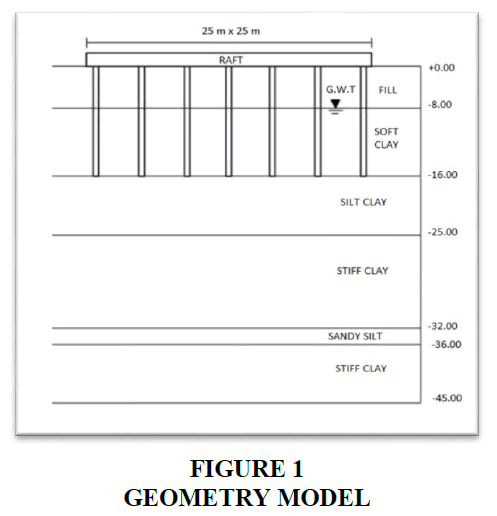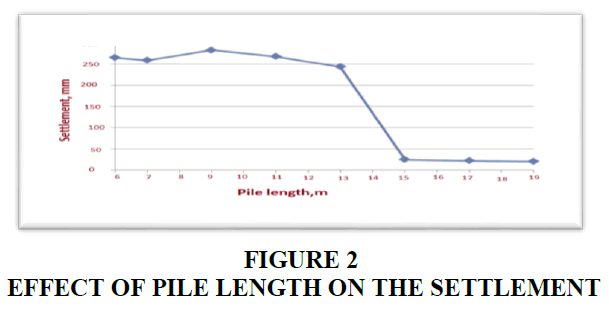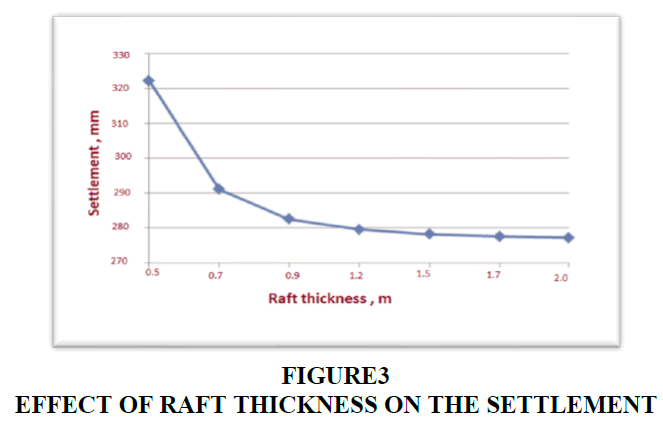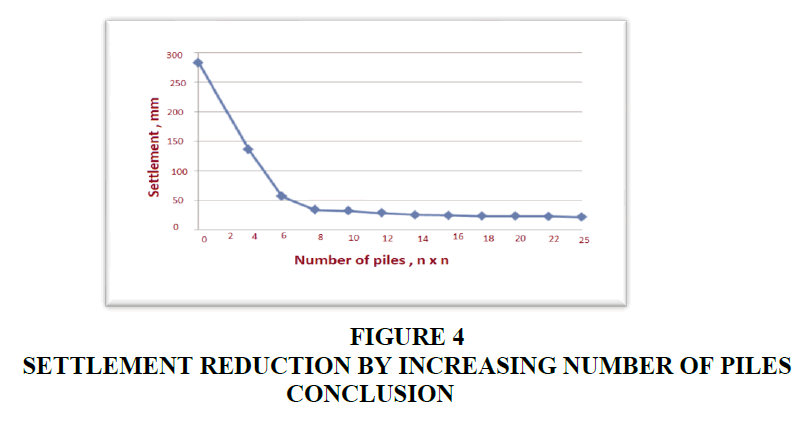Research Article: 2023 Vol: 26 Issue: 5S
Piled raft foundation Analysis in alluvial soil using GEOTECH 2D software
Devesh Ojha, Shri Ramswaroop University
Rajendra Kumar Srivastava, Shri Ramswaroop University
Citation Information: Ojha, D., & Srivastava, RK. (2023). Piled raft foundation analysis in alluvial soil using geotech 2d software. Journal of Management Information and Decision Sciences, 26 (S5),1-6.
Abstract
This study presents an analysis of piled raft foundations on alluvial soil using GEOTECH 2D software. Alluvial soil, known for its soft and compressible nature, poses significant challenges for foundation design and performance. Piled raft foundations, which combine the benefits of both rafts and piles, have gained attention as a potential solution to mitigate settlement and improve load-bearing capacity. The study focuses on the behaviour of piled raft foundations in alluvial soil by utilizing GEOTECH 2D software, a powerful numerical tool for geotechnical analysis. The software incorporates advanced soil modelling techniques, considering non-linear soil behaviour and soil-structure interaction effects. Key parameters, including soil properties, raft, and pile dimensions, and loading conditions, are input into the software to simulate the behaviour of piled raft foundations. The analysis evaluates settlement, stress distribution, and load-bearing capacity to assess the foundation's performance. The results demonstrate that piled raft foundations exhibit reduced settlement and improved load distribution compared to conventional raft foundations in alluvial soil. The presence of piles increases the stiffness of the foundation system, effectively mitigating settlement and improving overall stability. Moreover, the software allows for sensitivity analyses, enabling investigation of the influence of various design parameters on the foundation's response. This provides valuable insights for optimizing the design and construction of piled raft foundations in alluvial soil conditions. The study emphasizes the significance of considering alluvial soil characteristics and employing appropriate analysis tools for accurate foundation design. GEOTECH 2D software offers a reliable and efficient platform for analysing piled raft foundations, aiding engineers in developing safe and cost-effective solutions in alluvial regions. In conclusion, the analysis of piled raft foundations on alluvial soil using GEOTECH 2D software demonstrates its effectiveness in assessing foundation behaviour and optimizing design parameters. The findings contribute to enhancing the understanding and implementation of piled raft foundations, offering a viable solution for mitigating settlement and improving load-bearing capacity in alluvial soil conditions.
Keywords
Alluvial Soil, Raft, Pile Raft Foundation, Geotech 2D.
Introduction
The behaviour of foundations in alluvial soil poses significant challenges due to the soil's soft and compressible nature. To address these challenges, piled raft foundations have emerged as a promising solution. Piled raft foundations combine the advantages of both raft foundations and pile foundations, providing improved load-bearing capacity and reduced settlement. Analysing the performance of piled raft foundations in alluvial soil conditions requires advanced numerical tools such as GEOTECH 2D software, which employs finite element methods to model the complex soil-structure interaction. Alluvial soil, commonly found in river deltas and floodplains, exhibits low bearing capacity and high compressibility. These soil characteristics can lead to excessive settlement and differential settlement, compromising the stability of structures (Burland et al., 1977). Raft foundations, with their ability to distribute loads over a larger area, are commonly used in alluvial regions. However, conventional raft foundations may still experience significant settlement in alluvial soil. Piled raft foundations offer a solution to address these challenges by incorporating vertical piles within the raft system. The piles improve the load-bearing capacity by transferring the loads to deeper, more competent soil layers, reducing the settlement and differential settlement potential. Analysing the behaviour of piled raft foundations requires sophisticated geotechnical software like GEOTECH 2D. GEOTECH 2D software utilizes finite element methods to simulate the interaction between the piled raft foundation and the alluvial soil. It considers non-linear soil behaviour, accounting for soil shear strength, stress-strain relationships, and soil consolidation effects Viggiani (2001). By incorporating these complex soil models, GEOTECH 2D provides a comprehensive understanding of the foundation's response to loading. The analysis of piled raft foundations using GEOTECH 2D software enables engineers to assess critical factors such as settlement, stress distribution, and load-bearing capacity. It allows for sensitivity analyses, evaluating the influence of design parameters such as pile spacing, diameter, and raft thickness on the foundation's behavior (Alpan, 1964). This knowledge helps optimize the design and construction of piled raft foundations to ensure structural stability and mitigate the risk of excessive settlement and differential settlement in alluvial soil conditions. The objective of this study is to analyse the behaviour of piled raft foundations on alluvial soil using GEOTECH 2D software. The study aims to provide valuable insights into the performance of piled raft foundations, their ability to mitigate settlement and differential settlement, and their load-bearing capacity in alluvial regions. The findings from this analysis will contribute to advancing foundation design practices, offering engineers an effective tool for designing safe and reliable foundations in alluvial soil conditions (Bowles,1988).
Geometry Model
This study was conducted by applying a uniformly distributed load of 80 KN/m2 on pile raft foundation with raft dimensions as 25m x 25m. The model was of high rise 10 storey building that was constructed on alluvial soil. Modelling of raft and pile in pile raft foundation were done as a plate element in finite element analysis (Challinger, 2008).
To model pile -soil interaction has many limitations in 2D finite element analyses as pile -soil interaction is purely 3D phenomenon. During the modelling of piles with plate elements, adjustments were done to stiffness properties of these elements (Mali & Singh, 2018).
The geometry model and soil profile were as shown in Fig 1. On the surface, there is an 8 m thick fill layer. The next layer is soft clay from 8 m to 16 m depth. The silty clay is from 16 m to 25 m. The stratigraphy of soils below 25m is shown in Figure 1.
Material Properties
Modulus elasticity of raft and piles, E, of 2.35 x 107 kN/m2 were used. The entire soil material model was Mohr Coulomb, as shown in Table 1.
| Table 1 Soil Parameter | ||||||
| Parameter | FFill | Soft Clay | Silty Clay | Stiff Clay 1 | Sandy Silt | Stiff Clay 2 |
| Thickness (m) | 88 | 8 | 9 | 7 | 4 | 9 |
| Unit weight, (kN/m3) | 118 | 14 | 12 | 16 | 18 | 16 |
| Saturated unit weight, (kN/m3) | 222 | 19 | 22 | 19 | 22 | 19 |
| Young’s modulus, Es (kN/m2) | 990000 | 5000 | 30000 | 55000 | 20000 | 55000 |
| Poisson’s ratio | 00.40 | 0.30 | 0.40 | 0.35 | 0.35 | 0.35 |
| Undrained cohesion, cu (kN/m2) | 22 | 6 | 12 | 140 | 35 | 140 |
| Friction angle, (deg) | 440 | 0 | 20 | 10 | 20 | 10 |
Method of Analysis
Finite element analysis using GEOTEC 2D software was employed as the numerical method for the analysis of piled raft foundations on alluvial soil. GEOTEC 2D is a powerful software tool that utilizes the finite element method to simulate the complex interaction between the foundation system and the alluvial soil. The software divides the domain into finite elements, allowing for a detailed representation of the foundation and soil behaviour. It considers the non-linear characteristics of the soil, including shear strength, stress-strain relationships, and consolidation effects (Franke et al., 2000). The numerical analysis involved in putting the geometric and material properties of the piled raft foundation, as well as the properties of the alluvial soil. Loadings and boundary conditions were defined to replicate real-world scenarios (Mandolini et al., 2013). The software then solved the governing equations for each finite element, providing information on settlement, stress distribution, and load-bearing capacity of the foundation system. By employing finite element analysis using GEOTEC 2D, a comprehensive understanding of the behaviour of piled raft foundations in alluvial soil was achieved. The numerical analysis facilitated the assessment and optimization of design parameters, aiding engineers in developing safe and reliable foundation systems in alluvial regions (El-Mossallamy et al., 2006).
Finite element using GEOTEC 2D was used for numerical analysis. Three stages are there in the study of design process of pile raft foundation system. In the first stage the raft thickness was assessed. In the second stage assessment of pile length in pile raft foundation system was done and in the final stage, optimum number of piles required in pile raft foundation system was obtained (Ranjan & Rao, 2011).
Results and Discussion
The thickness of the raft in pile raft foundation system was varied from 0.5m to 2m in the first stage, to know the required thickness of raft considering the settlement. as in the figure 2, it can be seen clearly that as the raft thickness is increasing the settlement of the raft is getting decreased, but after 0.9m thickness to 2m, there is no difference in settlement so 0.9m thickness of raft was used for further analysis.
The pile length in the second stage was varied from 5 to 20 m to find out the required length of pile in pile raft foundation system. 8 x 8 piles of 25cm x 25cm size were used under the raft in pile raft system for assessment of settlement. In figure 3, as the length of piles are increasing the overall settlement of pile raft foundation system decreases but from pile length 15 to 20m, there is no change in the settlement that can be seen in the figure. so based on this result pile length 15 m was used in the assessment of third stage.
The optimum number of piles was determined in the final stage. In determining the optimum number of piles, pile length was considered as 15m that was determined in second stage and raft thickness as 0.9 m from first stage.
In figure 4, when piles number are increased from 8 x 8 to 25 x 25, there is no change in overall settlement of the pile raft foundation system, so it was concluded from this that optimum number of piles used are 8 x 8.
The analysis of piled raft foundations on alluvial soil using GEOTECH 2D software provides valuable insights into their behaviour and performance. The numerical analysis using finite element methods allows for a comprehensive understanding of settlement, stress distribution, and load-bearing capacity of the foundation system in alluvial soil conditions. The results obtained from the analysis indicate that piled raft foundations effectively mitigate settlement and differential settlement compared to conventional raft foundations. The inclusion of piles within the raft system improves the load-bearing capacity and distributes the loads to deeper, more competent soil layers. GEOTECH 2D software proves to be a powerful tool for simulating the complex soil-structure interaction in alluvial soil conditions. It enables engineers to optimize design parameters such as pile spacing, diameter, and raft thickness, leading to safer and more reliable foundation systems in alluvial regions. Overall, the analysis highlights the effectiveness of piled raft foundations in alluvial soil and emphasizes the importance of utilizing advanced numerical tools like GEOTECH 2D software for accurate assessment and design optimization in such challenging soil conditions.
References
Alpan, I. (1964). Estimating the settlements of foundations on sands. Civil Eng & Public Works Review/UK/, 59(700).
Bowles, J. E. (1988). Foundation analysis and design.
Indexed at, Google Scholar, Cross Ref
Burland, J. B., Broms, B. B., & De Mello, V. F. B (1977). Behaviour of foundations and structures. In Proc. 9th Int. Conf. Soil Mech. Found. Engng, Tokyo,2, 495-546.
Challinger, D. (2008). From the ground up: Security for tall buildings. CRISP Report. Alexandria, VA: ASIS Foundation Research Council, 4.
El-Mossallamy, Y., Lutz, B., & Richter, T. (2006). Innovative application of piled raft foundation to optimize the design of high-rise buildings and bridge foundations. In Proc. 10th Int. Conference on Piling and Deep Foundations, 31.
Franke, E., El-Mossallamy, Y., & Wittmann, P. (2000). Calculation methods for raft foundations in Germany. In Design applications of raft foundations, 283-322. Thomas Telford Publishing.
Indexed at, Google Scholar, Cross Ref
Mali, S., & Singh, B. (2018). Behavior of large piled-raft foundation on clay soil. Ocean Engineering, 149, 205-216.
Mandolini, A., Di Laora, R., & Mascarucci, Y. (2013). Rational design of piled raft. Procedia Engineering, 57, 45-52.
Ranjan, G., & Rao, A. S. R. (2011). Basic and applied soil mechanics. New Age International.
Viggiani, C. (2001). Analisi e progetto delle fondazioni su pali. I Arrigo Croce Lecture. Rivista Italiana di Geotecnica, 35(1), 17-46.
Received: 14-Jun-2023, Manuscript No. JMIDS-23-13696; Editor assigned: 15-Jun-2023, Pre QC No. JMIDS-23-13696(PQ); Reviewed: 29-Jun-2023, QC No. JMIDS-23-13696; Published: 29-June-2023



